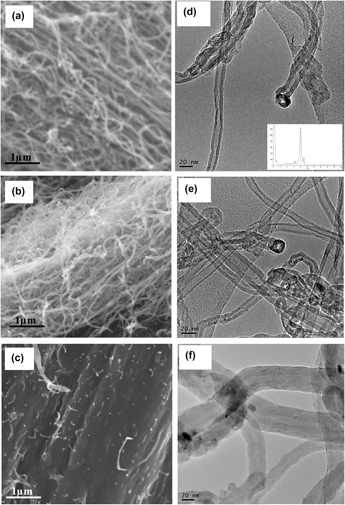Crossref Citations
This article has been cited by the following publications. This list is generated based on data provided by
Crossref.
Kusoglu, Ahmet
and
Weber, Adam Z.
2017.
New Insights into Perfluorinated Sulfonic-Acid Ionomers.
Chemical Reviews,
Vol. 117,
Issue. 3,
p.
987.
Glebova, N. V.
Krasnova, A. O.
and
Nechitailov, A. A.
2018.
Thermally Expanded Graphite as Functional Material in the Technology of Electrode Material with Mixed Conductivity.
Russian Journal of Applied Chemistry,
Vol. 91,
Issue. 8,
p.
1262.
Glebova, N. V.
Nechitailov, A. A.
and
Krasnova, A. O.
2020.
Thermal Degradation of Nafion in the Presence of Nanostructured Materials: Thermally Expanded Graphite, Carbon Black, and Platinum.
Russian Journal of Applied Chemistry,
Vol. 93,
Issue. 7,
p.
1034.
Atif, Muhammad
Afzaal, Imran
Naseer, Hira
Abrar, Maria
and
Bongiovanni, Roberta
2020.
Review—Surface Modification of Carbon Nanotubes: A Tool to Control Electrochemical Performance.
ECS Journal of Solid State Science and Technology,
Vol. 9,
Issue. 4,
p.
041009.
Bruzaca, Evellin E. S.
de Oliveira, Raissa C.
Duarte, Mateus S. S.
Sousa, Camila P.
Morais, Simone
Correia, Adriana N.
and
de Lima-Neto, Pedro
2021.
Electrochemical sensor based on multi-walled carbon nanotubes for imidacloprid determination.
Analytical Methods,
Vol. 13,
Issue. 18,
p.
2124.
Khan, Ibrahim
Lee, Ju Hyun
Park, Junyong
and
Wooh, Sanghyuk
2022.
Nano/micro-structural engineering of Nafion membranes for advanced electrochemical applications.
Journal of Saudi Chemical Society,
Vol. 26,
Issue. 4,
p.
101511.
Krasnova, Anna O.
Glebova, Nadezhda V.
Kastsova, Angelina G.
Rabchinskii, Maxim K.
and
Nechitailov, Andrey A.
2023.
Thermal Stabilization of Nafion with Nanocarbon Materials.
Polymers,
Vol. 15,
Issue. 9,
p.
2070.
Gao, Jiangshan
Dong, Xiaokun
Tian, Qingbin
and
He, Yan
2023.
Carbon nanotubes reinforced proton exchange membranes in fuel cells: An overview.
International Journal of Hydrogen Energy,
Vol. 48,
Issue. 8,
p.
3216.
Namathoti, Sivanagaraju
and
Vakkalagadda, Manikanta Ravindra Kumar
2023.
Development of Multiwalled Carbon Nanotubes/Halloysite Nanotubes Reinforced Thermal Responsive Shape Memory Polymer Nanocomposites for Enhanced Mechanical and Shape Recovery Characteristics in 4D Printing Applications.
Polymers,
Vol. 15,
Issue. 6,
p.
1371.
Hwang, Inhyeok
and
Kim, Kihyun
2023.
Perfluorosulfonic Acid Composite Membranes Containing Antioxidant Grafted Graphene Oxide for Polymer Electrolyte Membrane Fuel Cell Applications.
Membrane Journal,
Vol. 33,
Issue. 6,
p.
416.
Krasnova, Anna O.
Glebova, Nadezhda V.
Kastsova, Angelina G.
Pelageikina, Anna O.
Redkov, Alexey V.
Tomkovich, Maria V.
and
Nechitailov, Andrey A.
2024.
Stability of Graphene/Nafion Composite in PEM FC Electrodes.
Nanomaterials,
Vol. 14,
Issue. 11,
p.
922.
Fuku, Xolile G.
Mkhohlakali, Andile C.
Maumau, Thandiwe R.
and
Modibedi, Mmalewane R.
2024.
Nanoelectrocatalysts for Energy and Water Treatment.
Vol. 74,
Issue. ,
p.
197.
Heiba, Asmaa R.
Abdel-Salam, M. O.
Yoon, Taeho
and
El Sawy, Ehab
2025.
Zr-MOF composites with zipped and unzipped carbon nanotubes for high-performance electrochemical supercapacitors.
Nanoscale,
Vol. 17,
Issue. 1,
p.
459.
Kastsova, A. G.
Krasnova, A. O.
Glebova, N. V.
Pelageikina, A. O.
and
Nechitailov, A. A.
2025.
Long-term durability of membrane electrode assemblies of proton exchange fuel cells: challenges and solutions.
Russian Chemical Reviews,
Vol. 94,
Issue. 2,
p.
RCR5135.



